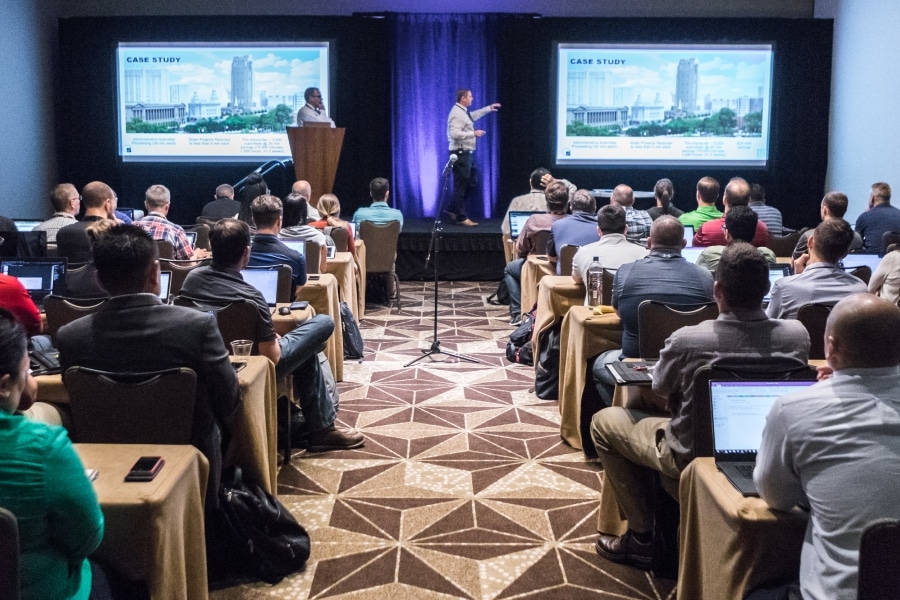Chloe Gharios loves pink. Her workspace is covered with it. She dons its different hues often, especially in the videos she publishes on social media, where she has an ardent following.
“I’ve always been that pink, loving, very girly person,” said Gharios, whose Instagram handle is @Chloetheengineer. “I love glitz. I love sparkles. My entire cubicle is hot pink and gold and out there, and I love it and I work best in it.”
Gharios’ unapologetic, outward display of love for everything pink represents more than just the color. It’s a symbol of a mantra she’s lived by her entire life—one that’s become especially important now that she’s advanced a successful young career as an engineer: “be yourself.”
Finding her way
For a long time, being authentic felt natural for Gharios. It was a foundational part of the environment her parents created for her.
For example, when Gharios wanted to join a basketball league as a kid like her big brother but there wasn’t a league for girls, her mother didn’t hesitate: “We’ll sign you up for the YMCA all-boys team. They can’t tell you no,” Gharios recalled her mom saying. “And when you go out there, you’re not a girl basketball player; you’re just a basketball player and as good as anyone else out there.”
But when it came time for Gharios to embark on a professional career, and that career was civil engineering, the “be yourself” credo became more challenging to uphold.
That’s because construction, a heavily male-dominated industry, and civil engineering, construction’s more-male-dominated cousin, aren’t always easy places for women to feel comfortable being themselves—especially women who love pink and all the “girly” things that the color may represent.
Women make up a small but growing percentage of the construction industry workforce. The number of women employed in the industry topped 1 million in May 2021, according to Bloomberg, a first since data collection began in 1964. As of July 2022, women now represent 14.1% of the construction industry, an all-time high.
Still, being a woman in construction remains challenging. Stereotypes abound; harassment is rampant. Construction isn’t just male-dominated; for a long time, it was a man’s world in almost every way. Much of the industry remains steeped in its traditionally masculine, blue-collar image, an ethos that endures even in non-jobsite roles.
Breaking norms
Gharios is one of many women aiming to shatter these norms, showing the women who work in construction—and, perhaps more importantly, girls who may join the industry someday—that being a woman on a jobsite doesn’t mean having to act like a man or dulling the feminine side of your personality.
This is why Gharios doesn’t hold back on being authentic, no matter how difficult it may be sometimes. So she wears pink to work—lots of it—and decorates her office in loud, feminine colors and decor.
“I have amazing co-workers who embrace it and love it,” Gharios said of her authenticity, “and I also have co-workers who think I’m insane and don’t know what to do with me.”
Gharios’ fearless authenticity isn’t something she keeps private. A few years ago, Gharios shifted her social media persona to focus more on the lifestyle of being a woman in a science, technology, engineering and mathematics (STEM) field such as engineering.
Through her Instagram, which has more than 10,000 followers, Gharios creates video and visual content documenting her everyday career trials and tribulations while also surgically discrediting persistent industry stereotypes on women in construction, architecture and engineering.
Gharios’ posts range from clever satirical commentary on typical female jobsite experiences—being called “sweetie” from a male colleague, for instance—to day-in-the-life glimpses into her experience as an engineer to personal home renovation projects and, of course, pictures of her dog, Mia.
RELATED:
“Social media has really presented me this opportunity to reach so many more high school and college students than I ever could going into classrooms and speaking at conferences,” Gharios said.
“The biggest thing for me is to just help us [women] be heard,” she added. “If there is that person in the conference room that wants to speak over everyone—whether it’s a man or woman—be the one to speak up and say, ‘She wasn’t done speaking’ or ‘Let’s hear what she has to say.’ Sometimes it’s not even huge gestures; it’s just things that slip under the radar but make a big impact.”
While her social media presence is indeed focused on encouraging women to explore STEM professions, Gharios said that her message is relevant to a broader audience.
“I really try to make my page for everyone,” she said. “It’s not just women in STEM I try to speak to. I also have a lot of amazing male followers who ask me advice and ask me questions about the industry, and I absolutely love that.”
Gharios said she isn’t out to “force” women into STEM professions. She just wants to show that being a woman doesn’t mean you’re limited to where you can go in your career, and that men need to be more self-aware of how they may inadvertently treat women, or others, at work.
“Really my true message is that everyone that is interested in STEM can be in STEM. It can be for everyone,” Gharios said. “Engineering is for everyone. And if we’re going to create a world for everyone, then everyone has to have a say. No matter your background, thought processes, hobbies—anything—there’s no stereotypes for being in STEM, even for men.”










